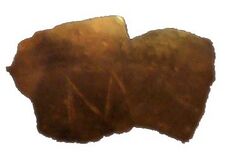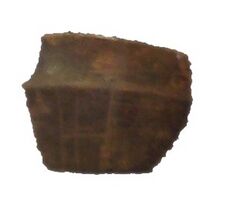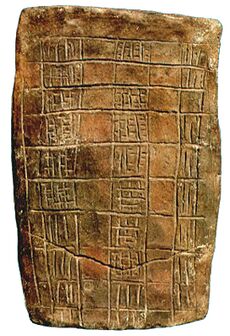Social:Vinča symbols
The Vinča symbols or Vinča–Turdaș signs, Old European script,[1] Danube script[2] (among other names[lower-alpha 1]) are a set of untranslated symbols found on Neolithic era artifacts from the Vinča culture and other related "Old European" cultures of Central and Southeastern Europe.[3] Whether this is one of the earliest writing systems or simply symbols of some sort is disputed.[4] They have sometimes been described as an example of "pre-writing" or "proto-writing".[5] The symbols went out of use around 3,500 BC.[6]
Discovery

In 1875, archaeological excavations directed by the Hungarian archaeologist Baroness Zsófia Torma (1840–1899) at Tordos (present Turdaș, Romania) unearthed marble and fragments of pottery inscribed with previously unknown symbols. At the site, on the Mureş river, a feeder into a tributary of the Danube, female figurines, pots, and artifacts made of stone were also found.[8] In 1908, a similar cache was found during excavations directed by Serbian archaeologist Miloje Vasić (1869–1956) in Vinča, a suburb of Belgrade (Serbia), some 245 km from Turdaș.[9] Later, more such fragments were found in Banjica, another part of Belgrade. Since 1875, over 150 Vinča sites have been identified in Serbia alone, but many, including Vinča itself, have not been fully excavated.[10]
The discovery of the Tărtăria tablets in Romania by a team directed by Nicolae Vlassa in 1961 revived debate regarding the inscriptions. Vlassa believed them to be pictograms. Other items found at the site of the discovery were subsequently radiocarbon-dated to before 4,000 BC,[lower-alpha 2] around 1,300 years earlier than the date Vlassa expected and pre-dating the writing systems of the Sumerians and Minoans. However, the circumstances of their discovery and authenticity of the tablets themselves is disputed.[7]
The Gradeshnitsa tablets are clay artefacts with incised marks. They were unearthed in 1969 near the village of Gradeshnitsa in the Vratsa Province of north-western Bulgaria. The tablets are dated to the 4th millennium BC and are currently preserved in the History Museum of Vratsa.[12][better source needed]
Corpus
Although a large number of symbols are known, most artifacts contain so few symbols that they are very unlikely to represent a complete text. Possibly the only exception is the Sitovo inscription in Bulgaria, the dating of which is disputed; regardless, even that inscription has only around 50 symbols.[citation needed]
Most of the inscriptions are on pottery, with the remainder appearing on ceramic spindle whorls, figurines, and a small collection of other objects. The symbols themselves consist of a variety of abstract and representative pictograms, including zoomorphic (animal-like) representations, combs or brush patterns and abstract symbols such as swastikas, crosses and chevrons. Over 85% of the inscriptions consist of a single symbol. Other objects include groups of symbols, of which some are arranged in no particularly obvious pattern, with the result that neither the order nor the direction of the signs in these groups is readily determinable. The usage of symbols varies significantly between objects; symbols that appear by themselves tend almost exclusively to appear on pots, while symbols that are grouped with other symbols tend to appear on whorls. Quantitative linguistic analysis leads to the conclusion that 59% of the signs share the properties of pottery marks, 11.5% are part of asymmetric ornaments typical for whorls of the Vinča culture, and 29.5% may represent some sort of symbolic (semasiographic) notation.[13]
A database of Vinča inscriptions, DatDas, has been developed by Marco Merlini:
DatDas organizes a catalogue of 5,421 actual signs. These are recorded from a corpus of 1,178 inscriptions composed of two or more signs and 971 inscribed artifacts (some finds have two or more inscriptions).[14]
Dating
These findings are important because the bulk of the Vinča symbols were created between 4,500 and 4,000 BC, with the symbols on the Tărtăria clay tablets possibly dating back to around 5,300 BC (controversially dated by association).[15] This means that the Vinča finds predate the proto-Sumerian pictographic script from Uruk (modern Iraq), which is usually considered to be the oldest known writing system, by more than a thousand years. Analyses of the symbols showed that they have little similarity with Near Eastern writing, resulting in the opinion that these symbols and the Sumerian script probably arose independently.[citation needed]
Meaning and interpretations
The nature and purpose of the symbols is a mystery. Many attempts have been made to interpret the symbols but there is no agreement as to what they might mean. Although they are unlikely to represent writing, the general practice of using symbols to express ideas may date as early as the Lower Paleolithic, and the Vinča symbols may have served a range of purposes such as representions of ownership, emblems of individual or communal identity, or sacred symbolism on religious objects.[16]
Property marks
Some researchers, such as Milutin Garašanin (archaeologist) (sr) and Dragoslav Srejović, have suggested that the symbols were potters' marks or owners' marks, meaning "this belongs to X".[17][4] Some symbols, principally those restricted to the base of pots, are wholly unique and such signs may denote the contents, the provenance or destination, or the manufacturer or owner of the pot. However, some of the symbols have been repeatedly found throughout the territory of the Vinča culture, dated hundreds of years apart, and in locations kilometers away from each other.[citation needed]
Numerical signs
Some of the "comb" or "brush" symbols, which collectively constitute as much as a sixth of all the symbols so far discovered, may represent a form of prehistoric counting. The Vinča culture appears to have traded its wares quite widely with other cultures, as demonstrated by the widespread distribution of inscribed pots, so it is possible that the "numerical" symbols conveyed information about the value of the pots or their contents.[citation needed] Other cultures, such as the Minoans and Sumerians, used their scripts primarily as accounting tools; the Vinča symbols may have served a similar purpose.[original research?]
Religious symbolism
The symbols may have been used for ritual or commemorative purposes.[19] If this was so the fact that the same symbols were used for centuries with little change suggests that the ritual meaning and culture represented by the symbols likewise remained constant for a very long duration, undergoing little further development during that time. However, the use of the symbols seems to have been abandoned (along with the objects on which they appear) at the start of the Bronze Age, suggesting that the new technology brought with it significant changes in social organization or population, and beliefs.[citation needed]
The anthropologist Marija Gimbutas interpreted the inscribed objects as votive offerings.[20] One argument in favour of the ritual explanation is that the objects on which the symbols appear do not seem to have had much long-term significance to their owners – they are commonly found in pits and other refuse areas.[citation needed] Certain objects, principally figurines, are most usually found buried under houses. This is consistent with the supposition that they were prepared for household religious ceremonies in which the signs incised on the objects represent expressions: a desire, request, vow, etc. After the ceremony was completed, the object would either have no further significance (hence would be disposed of) or would be buried ritually.
Early writing or proto-writing
The markings may represent an early writing system, namely the Vinča or Vinča–Turdaș script. Archaeologically determining if a corpus of symbols expresses a form of writing is immensely difficult, but it is not likely that the stateless societies of Neolithic Europe would have had cause to independently invent writing. Writing was typically developed to facilitate the accounting and records management required for the administration of complex socio-political and economic systems in early state societies, and there is no evidence that such institutions ever existed in the Vinča culture.[21]
Some researchers, such as Marija Gimbutas and archaeo-semiologist Marco Merlini, have argued that the Vinča symbols belonged to a wider tradition of literacy in Old Europe, which they referred to the "Old European script" and the "Danube script" respectively.[14] Gimbutas reconstructed a hypothetical pre-Indo-European "Civilization of Old Europe", which she defines as having occupied the area between the Dniester valley and the Sicily-Crete line.[22] She incorporated the Vinča markings into her model of Old Europe, suggesting that they might either be the writing system for an Old European language, or, more probably, a kind of symbolic "pre-writing" system. However, this has been generally met with skepticism.[4] Vinča symbols themselves have not been found on an area wider than southeastern Hungary, western Romania, and western Bulgaria, as described by Winn.[23]
See also
Notes
References
Citations
- ↑ (http://www.prehistory.it/ftp/winn.htm)
- ↑ (https://www.archaeomythology.org/wp-content/uploads/2012/01/2008-vol4-intro1.pdf)
- ↑ Haarmann (2010), 10: 5300–3200 BC.
- ↑ 4.0 4.1 4.2 Kruk & Milisauskas (2002), p. 236.
- ↑ Owens (1999).
- ↑ Lazarovici & Merlini (2016).
- ↑ 7.0 7.1 Qasim (2013).
- ↑ Torma (1879).
- ↑ Vasić (1932), Vasić (1936a), Vasić (1936b), and Vasić (1936c)
- ↑ Tasić, Srejović & Stojanović (1990).
- ↑ Merlini & Lazarovici (2008).
- ↑ "The Gradeshnitsa Tablets". 4 November 2007. https://www.omda.bg/public/engl/history/selishte21_engl.htm.
- ↑ Mäder (2019).
- ↑ 14.0 14.1 Merlini (2009).
- ↑ Haarmann (2002), p. 20.
- ↑ Kruk & Milisauskas (2011), p. 267–269.
- ↑ Starović (2005).
- ↑ Haarmann (2020).
- ↑ Kruk & Milisauskas (2011), p. 269.
- ↑ Gimbutas (2007), pp. 85–88.
- ↑ Kruk & Milisauskas (2011), p. 268–269.
- ↑ Gimbutas (2007), p. 16-35.
- ↑ Winn (1981), p. 15.
Bibliography
- Gimbutas, Marija (2007). The Goddesses and Gods of Old Europe, 6500–3500 BC: Myths and Cult Images (New and updated ed.). Berkeley: University of California Press. ISBN 9780520253988.
- Haarmann, Harald (2002) (in de). Geschichte der Schrift. München: C.H. Beck. ISBN 3-406-47998-7.
- Haarmann, Harald (2010) (in de). Einführung in die Donauschrift. Hamburg: Buske. ISBN 978-3-87548-555-4.
- Haarmann, Harald (2020). The Mystery of the Danube Civilisation. Marix Verlag. ISBN 9783843806466. https://books.google.com/books?id=tiLoDwAAQBAJ.
- Kruk, Janusz; Milisauskas, Sarunas (2002). "Middle Neolithic, Continuity, Diversity, Innovations, and Greater Complexity, 5500/5000–3500/3000 BC". in Milisauskas, Sarunas. European Prehistory: A Survey (1st ed.). Springer. pp. 193–246. ISBN 978-0-306-46793-6.
- Kruk, Janusz; Milisauskas, Sarunas (2011). "Middle Neolithic/Early Copper Age, Continuity, Diversity, and Greater Complexity, 5500/5000–3500 BC". in Milisauskas, Sarunas. European Prehistory: A Survey (2nd ed.). New York: Springer. pp. 223–292. ISBN 978-1-4419-6632-2.
- Lazarovici, Gheorghe; Merlini, Marco (2016). "Tărtăria Tablets: The Latest Evidence in an Archaeological Thriller". in Nikolova, Lolita. Western-Pontic Culture Ambience and Pattern: In memory of Eugen Comsa. Warsaw, Poland: De Gruyter Open Poland. pp. 53–142.
- Mäder, Michael (2019) (in de). Ist die Donauschrift Schrift?. Budapest: Archaeolingua. ISBN 978-615-5766-29-9.
- Merlini, Marco; Lazarovici, Gheorghe (2008). "Settling discovery circumstances, dating and utilization of the Tărtăria tablets". Acta Terrae Septemcastrensis 7. ISSN 1583-1817. http://arheologie.ulbsibiu.ro/publicatii/ats/ats8/acta%207.pdf.
- Merlini, Marco (2009). Altip, Alba Iulia. ed. "Neo-Eneolithic Literacy in Southeastern Europe: an Inquiry into the Danube; Introduction to the Danube script". Biblioteca Brukenthal 33. https://www.academia.edu/3035626.
- Owens, Gareth A. (1999). "Balkan Neolithic Scripts". Kadmos 38 (1–2): 114–120. doi:10.1515/kadm.1999.38.1-2.114.
- Qasim, Erika (2013). "Die Tărtăria-Täfelchen – eine Neubewertung" (in de). Das Altertum 50 (4): 307–318. ISSN 0002-6646.
- Starović, Andrej (2005). "If the Vinča script once really existed who could have written or read it?". Documenta Praehistorica 32: 253–260. doi:10.4312/dp.32.19.
- Tasić, Nikola; Srejović, Dragoslav; Stojanović, Bratislav (1990), Vinča: Centre of the Neolithic Culture of the Danubian Region, Belgrade: Centre for Archaeological Research Faculty of Philosophy, http://www.rastko.rs/arheologija/vinca/vinca_eng.html
- Torma, Zsófia (1879). "Neolith kökorszakbeli telepek Hunyad megyében" (in hu). Transylvanian Museum (journal, 1874–) (hu) (Cluj: Transylvanian Museum Association (hu)) 5, 6, and 7: 129–155, 190–192, and 193–211.
- Vasić, Miloje (1932) (in sr). Preistorijska Vinča I. Belgrade: State Printing House of the Kingdom of Yugoslavia.
- Vasić, Miloje (1936a) (in sr). Preistorijska Vinča II. Belgrade: State Printing House of the Kingdom of Yugoslavia.
- Vasić, Miloje (1936b) (in sr). Preistorijska Vinča III. Belgrade: State Printing House of the Kingdom of Yugoslavia.
- Vasić, Miloje (1936c) (in sr). Preistorijska Vinča IV. Belgrade: State Printing House of the Kingdom of Yugoslavia.
- Winn, Shan M.M. (1981). Pre-writing in Southeastern Europe: the sign system of the Vinča culture, ca. 4000 BC. Calgary: Western Publishers. ISBN 9780919119093.
Further reading
- Chapman, John (1981). The Vinča culture of South-East Europe: studies in chronology, economy and society. Oxford: British Archaeological Reports. ISBN 9780860541394.
- Palavestra, Aleksandar (2017). "All Shades of Gray: the Case of "Vinča Script".". Архаика 5: 143–165. https://www.academia.edu/36456625.
- Wu, K.; Solman, J.; Linehan, R.; Sproat, R. (2012). "Corpora of Non-Linguistic Symbol Systems". Lsa Annual Meeting Extended Abstracts (Linguistic Society of America) 3: 4–1. doi:10.3765/exabs.v0i0.576.
External links
| Wikimedia Commons has media related to Vinča symbols. |
- 2008 Symposium The Danube Script: Neo-Eneolithic Writing in Southeastern Europe. Held in Romania
- Vinca-Tordos symbols at omniglot.com, including a font created by Romanian linguist Sorin Paliga
- The Old European Script: Further evidence – Shan M. M. Winn
 |






